 W
WCake decorating is one of the sugar arts that uses icing or frosting and other edible decorative elements to make plain cakes more visually interesting. Alternatively, cakes can be molded and sculpted to resemble three-dimensional persons, places and things.
 W
WSil-gochu (실고추), often translated as chili threads, chilli threads, or chili pepper threads, is a traditional Korean food garnish made with chili peppers.
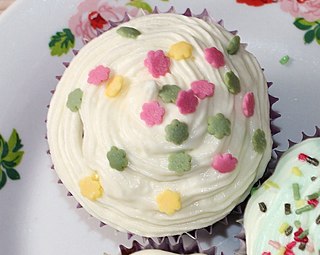 W
WConfetti candy is a confectionery food product that is prepared with cooked sugar and corn syrup that is formed into sheets, cooled, and then cracked or broken into pieces. It has a hard, brittle texture. To add eye appeal, colored sugar is sometimes sprinkled atop after the cooking and shaping process has been performed.
 W
WCookie decorating dates back to at least the 14th century when in Switzerland, springerle cookie molds were carved from wood and used to impress Biblical designs into cookies.
 W
WCricut is a brand of cutting plotters, or computer-controlled cutting machines, designed for home crafters. The machines are used for cutting paper, felt, vinyl, fabric and other materials such as leather, matboard, and wood.
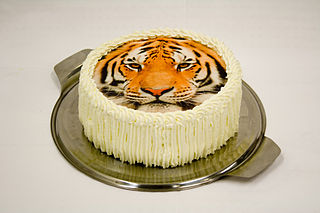 W
WEdible ink printing is the process of creating preprinted images with edible food colors onto various confectionery products such as cookies, cakes and pastries. Designs made with edible ink can be either preprinted or created with an edible ink printer, a specialty device which transfers an image onto a thin, edible paper.
 W
WEgg garnish, called al-gomyeong (알고명) in Korean, is a common topping in Korean cuisine, made with egg whites and egg yolks. Egg yolks and egg whites are separated, beaten without creating foam, pan-fried with little oil into thin sheets without browning, then cut into thin strips, diamonds, or rectangles. The white and yellow egg sheets before being cut are called jidan (지단).
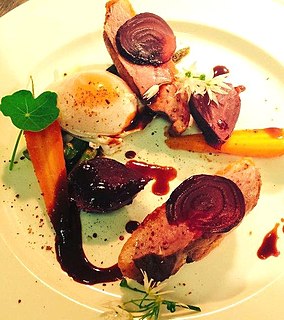 W
WFood presentation is the art of modifying, processing, arranging, or decorating food to enhance its aesthetic appeal.
 W
WA garnish is an item or substance used as a decoration or embellishment accompanying a prepared food dish or drink. In many cases, it may give added or contrasting flavor. Some garnishes are selected mainly to augment the visual impact of the plate, while others are selected specifically for the flavor they may impart. This is in contrast to a condiment, a prepared sauce added to another food item primarily for its flavor. A food item which is served with garnish may be described as being garni, the French term for "garnished."
 W
WA gingerbread house is a novelty confectionery shaped like a building that is made of cookie dough, cut and baked into appropriate components like walls and roofing. The usual material is crisp ginger biscuit made of gingerbread – the ginger nut. Another type of model-making with gingerbread uses a boiled dough that can be moulded like clay to form edible statuettes or other decorations. These houses, covered with a variety of candies and icing, are popular Christmas decorations.
 W
WGomul (고물) refers to a number of powdered coatings, toppings, fillings, or dips in Korean cuisine.
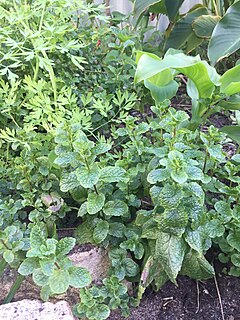 W
WIn general use, herbs are plants with savory or aromatic properties that are used for flavoring and garnishing food, for medicinal purposes, or for fragrances; excluding vegetables and other plants consumed for macronutrients. Culinary use typically distinguishes herbs from spices. Herbs generally refers to the leafy green or flowering parts of a plant, while spices are usually dried and produced from other parts of the plant, including seeds, bark, roots and fruits.
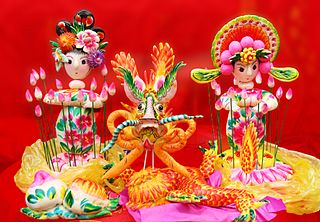 W
WHuamo is a Chinese method of decorating specially shaped mantou. Huamo are a feature of the folk art of Shanxi and are often prepared for festivals such as Qingming. Wenxi County in Shanxi is particularly renowned for its huamo. Many shapes such as fish, guanmao, birds and dragons are used.
 W
WA jack-o'-lantern is a carved pumpkin, turnip, or other root vegetable lantern associated with Halloween. Its name comes from the phenomenon of a strange light flickering over peat bogs, called will-o'-the-wisp or jack-o'-lantern. The name is also tied to the Irish legend of Stingy Jack, a drunkard who bargains with Satan and is doomed to roam the Earth with only a hollowed turnip to light his way.
 W
WIn cuisine a manchette is a paper frill attached to the exposed end of a bone of a cooked piece of meat.
 W
WMiniature food is a replica of a dish made at a much smaller scale than the original. It may be in the form of an inedible toy or accessory, or an edible foodstuff either made from the same ingredients as the original dish, candy or other substitute. Miniature food is an example of miniature art.
 W
WMukimono (剥き物) is the traditional Japanese art of decorative garnishing. Examples of this include carving traditional images into skins of fruit and vegetables, as well as carving vegetables into attractive shapes such as flowers, twists, and fan shapes. These are commonly served as a garnish on the same plate as the meal, or on a small side plate. Carving is done using a kitchen knife. Mukimono is different from the Thai fruit carving that uses a sharp thin knife specifically designed for this purpose.
 W
WThe Night of the Radishes is an annual event held on December 23 in Oaxaca, Mexico, dedicated to the carving of oversized radishes to create scenes that compete for prizes in various categories.
 W
WPolonaise sauce, in English also known as Polish-styled garnish, is a simple vegetarian sauce in the form of garnish, which originated in Poland and became popular in France in the 18th-century. The sauce consists of melted butter, chopped boiled eggs, bread crumbs, salt, lemon juice and herbs such as thyme, basil and parsley. It is poured over cooked or steamed vegetables, most notably cauliflowers, asparagus, wax beans and broccoli. The sauce is not to be confused with velouté à la polonaise or Bolognese.
 W
WA ristra is an arrangement of drying chile pepper pods, garlic bulbs, or other vegetables for later consumption. In addition to its practical use, the ristra has come to be a trademark of decorative design in the state of New Mexico as well as southern Arizona. Typically, large chiles such as New Mexico chiles and Anaheim peppers are used, although any kind of chile may be used.
 W
WSautéed mushrooms is a flavorful dish prepared by sautéing edible mushrooms. It is served as a side dish, used as an ingredient in dishes such as coq au vin and beef bourguignon, in foods such as duxelles, as a topping for steaks and toast, and also as a garnish.
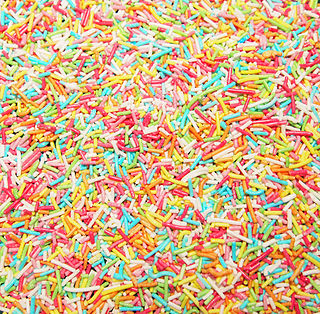 W
WSprinkles are very small pieces of confectionery used as a decoration or to add texture to desserts such as brownies, cupcakes, doughnuts or ice cream. The tiny candies are produced in a variety of colors and are generally used as a topping or a decorative element. The Dictionary of American Regional English defines them as "tiny balls or rod-shaped bits of candy used as a topping for ice-cream, cakes and other."
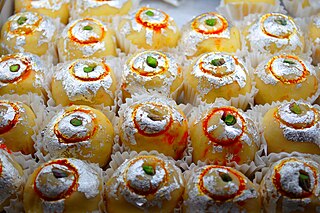 W
WVark, also called varak, is super fine filigree foil sheet of pure metals, typically silver but sometimes gold, used to decorate South Asian sweets and food, but also placed on mounds of saffroned rice served on platters, to make those look more appetising. The silver and gold are edible, though flavorless. Varak is made by pounding silver into sheets less than one micrometre (μm) thick, typically 0.2 μm-0.8 μm. The silver sheets are typically packed between layers of paper for support; this paper is peeled away before use. It is fragile and breaks into smaller pieces if handled with direct skin contact. Leaf that is 0.2 μm thick tends to adhere to skin if handled directly. Vark sheets are laid or rolled over some South Asian sweets, confectionery, dry fruits and spices. For safety and ethical reasons, the government of India has issued food safety and product standards guidelines for manufacturers of silver foil.
 W
WVegetable carving is the art of carving vegetables to form beautiful objects, such as flowers or birds.
 W
WA wedding cake topper is a small model that sits on top of a wedding cake, normally a representation of the couple in formal wedding attire.